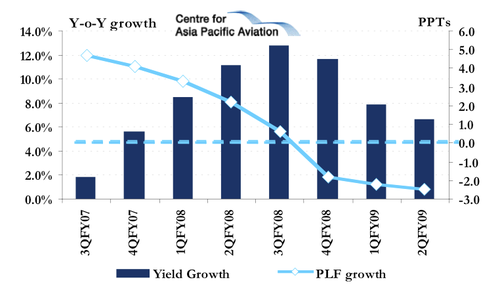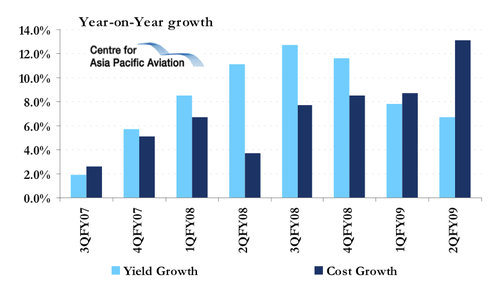Singapore Airlines sees weak demand in 2009
Singapore Airlines unveiled a 36.2% fall in Group net profit in the three months ended 30-Sep-08 and warned of storm conditions ahead.
Passenger load factors have been falling for three quarters now, while yield growth peaked in the Oct-Dec-07 quarter (SIA's third quarter last financial year). The global economic downturn is expected to place further downward pressure on yield in the months ahead.
Singapore Airlines Group passenger yield growth vs passenger load factor growth: 3QFY07 to 2QFY09 (year ended 31-Mar)

Cost growth significantly outstripped yield growth in the latest quarter.
Singapore Airlines Group passenger yield growth vs passenger unit costs growth: 3QFY07 to 2QFY09 (year ended 31-Mar)

As such, the gap between actual and break-even load factors continues to close.
Singapore Airlines Group passenger load factor vs passenger breakeven load factor: 2QFY06 to 2QFY09 (year ended 31-Mar)

Second quarter and first half financial summary
The Singapore Airlines Group financial/traffic highlights for the three months ended 30-Sep-08 included:
- Revenue: SGD4,379 million, +10.4% year-on-year;
- Operating costs: SGD4,148 million, +20.3%;
- Fuel costs: +53.9%;
- Operating profit: SGD231.7 million, -55.2%;
- Net profit: SGD323.8 million, -36.2%;
- Passenger numbers: 4.8 million, +1.4%;
- Passenger load factor: 79.1%, -2.5 ppts;
- Yield (per RPK): +6.7%;
- Unit costs (per ASK): +11.7%;
The first half highlights were as follows:
- Revenue: SGD8,511 million, +12.1% year-on-year;
- Airlines: SGD6,954 million, +14.7%;
- Operating costs: SGD7,936 million, +20.1%;
- Airlines: SGD6,459 million, +22.3%;
- Fuel costs: +43%;
- Operating profit: SGD574.9 million, -41.4%;
- Airlines: SGD495.2 million, -36.6%;
- Net profit: SGD682.4 million, -26.8%;
- Passenger numbers 9.6 million, +2.4%;
- Passenger load factor: 77.9%, -2.4 ppts;
- Passenger breakeven load factor: 72.2%, +2.1 ppts;
- Yield (per RPK): +7.7%;
- Unit costs (per ASK): +11.0%.
During the first half, the recently crowned CAPA Asia Pacific Airline of the Year took delivery of three Airbus A380-800s and four Boeing B777-300ERs, and decommissioned four Boeing B747-400s. As at 30-Sep-08, the operating fleet comprised 101 aircraft - 14 B747-400s, 76 B777s, five A340-500s and six A380-800s - with an average age of six years and three months.
All major subsidiary companies contributed poorer profit results in the first half:
- SATS Group: SGD82 million, -12.5% year-on-year;
- SIA Engineering: SGD57 million, -10.7%;
- SilkAir: SGD5 million, -44.6%;
- SIA Cargo: (SGD76 million), compared to a profit of SGD19 million previously.
Outlook challenging, but SIA working from a position of strength
SIA stated the financial turmoil around the world and weak consumer confidence are impacting demand for air transportation and lthough advance bookings for the immediate next quarter are holding up reasonably well, "there are signs of weakness beyond that".
The airline noted that while fuel prices have retreated, but fuel remains the biggest single item of operating expenditure.
But other challenges are weighing on the airline, including recent volatility in currency markets presents. The carrier stated that with fuel and aircraft related payments in US dollars, the sharp appreciation of the US dollar and the concurrent depreciation of the Euro, UK pound and Australian dollar "is an adverse development, partially mitigated by the company's ongoing currency hedging programme".
SIA suspended services to Osaka via Bangkok from May-08 and Los Angeles via Taipei from Oct-08. From Feb-09, services to Amritsar will also be withdrawn. For the Northern Winter schedule, the Company will be making progressive changes to flight frequencies to destinations in Southeast Asia (Penang and Ho Chi Minh), North Asia (Seoul and Osaka) and West Asia (Bangalore and Chennai).
The airline concluded that its sound finances and low level of debt "put it in a position of strength" and management would monitor business trends closely and respond appropriately.